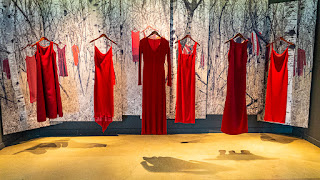Winnipeg, Part Two –
The Canadian Museum for Human Rights
“Everyone on Earth should visit this museum...”
- online review of the Canadian Museum for Human Rights,
September 28, 2019
The Canadian Museum for Human Rights (CMHR) (link) is both humbling and inspirational. It is Winnipeg’s gift to humanity.
Located at the confluence of the Red and Assiniboine Rivers in central Winnipeg – aka, The Forks – this impressive museum combines breathtaking architecture with immersive, challenging exhibits. It was opened in 2014, a tribute to Izzy Asper, the man who championed the idea of creating a Winnipeg museum dedicated to human rights. Alas, Asper – a respected Winnipeg politician, lawyer, philanthropist, and media mogul – never lived to see the completion of his dream.
The architects of the building are Antoine Predock and Chris Beccone, both based in Albuquerque, New Mexico. Their proposal for the CMHR won an international design competition in 2003. You can see it on the back of the new Canadian ten dollar bill that is dedicated to the human rights champion Viola Desmond.
The purpose of the CMHR is, in the words of its mission statement, “to explore the subject of human rights with a special but not exclusive reference to Canada, to enhance the public’s understanding of human rights, to promote respect for others and to encourage reflection and dialogue.”
Its exhibits explore the ongoing nightmare of antisemitism and the Holocaust; the 1930s Ukrainian Holodomor; the 1994 genocide of Tutsis in Rwanda; and the continuing plight of the Rohingya in Myanmar.
It also covers Canadian topics such as anti-black racism in Canada (with a focus on the experience of Viola Desmond in Nova Scotia); the rights of working people in Canada (with a focus of the 1919 Winnipeg General Strike); the rights of women in Canada (with a focus on the right to vote and the famous 1929 ‘Persons’ case); and the rights of LGBTQ2 people in Canada (with a focus on equal marriage).
For me, the museum’s most moving section was its exploration of the shameful treatment of Indigenous and First Nations people in Canada. Its focus on the horrors of state-sponsored/church-operated residential schools and murdered/missing Indigenous women was deeply troubling. Unlike the Conservative Party of Canada, the CMHR does not shy away from accurately describing this treatment as genocide.
The museum also features opportunities for personal reflections on what we can each do to further human rights in Canada and the wider world.
When you go to this museum, please do not make the mistake that I made – I could only spend a morning there, but the CMHR deserves at least a full day. The next time I visit, I intend to schedule more time at the museum.
The museum is fully accessible and offers an excellent restaurant. I found the staff and volunteers to be friendly, informed, and non-intrusive.
I hope the photos that follow give you a flavour of the Canadian Museum for Human Rights and its surrounding area in The Forks. Next week, I plan to write about the experience of driving through Northern/Northwestern Ontario with Bill on our way to/from Winnipeg.
As always, thank you for reading my blog.
Exterior Detail.
Statue of Mahatma Gandhi at the entrance
to the Canadian Museum for Human Rights.
Created by the renowned Indian sculptor,
Ram Vanji Sutor.
Main Exhibit Hall.
"From Sorrow to Strength -
Indigenous Women and the Right to Safety and Justice."
Not part of an exhibit,
but moving nonetheless.
The interior ramps (detail).
Early evening view.
Nearby bridge detail.
Park adjacent to the CMHR.










No comments:
Post a Comment